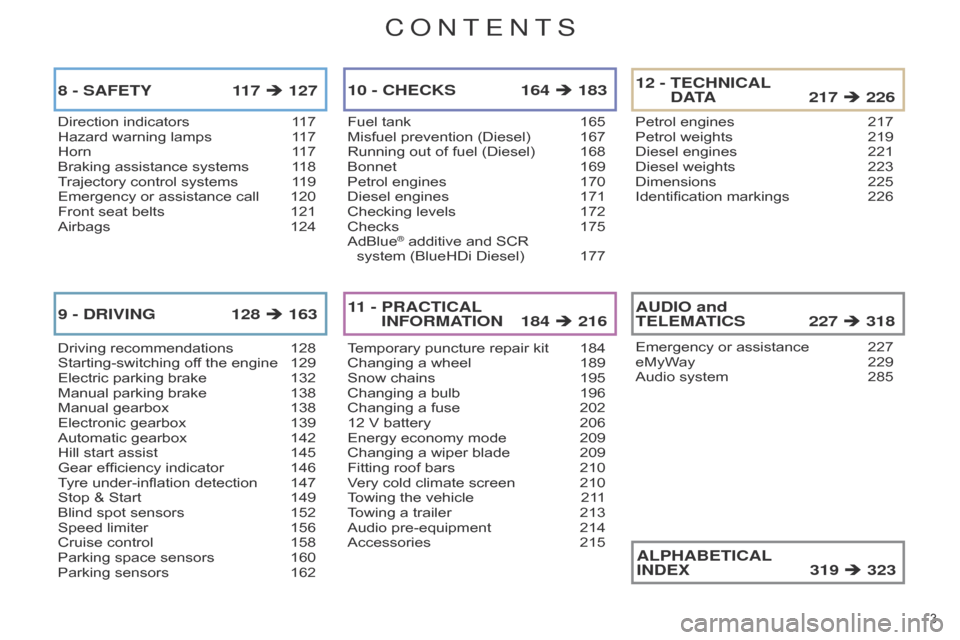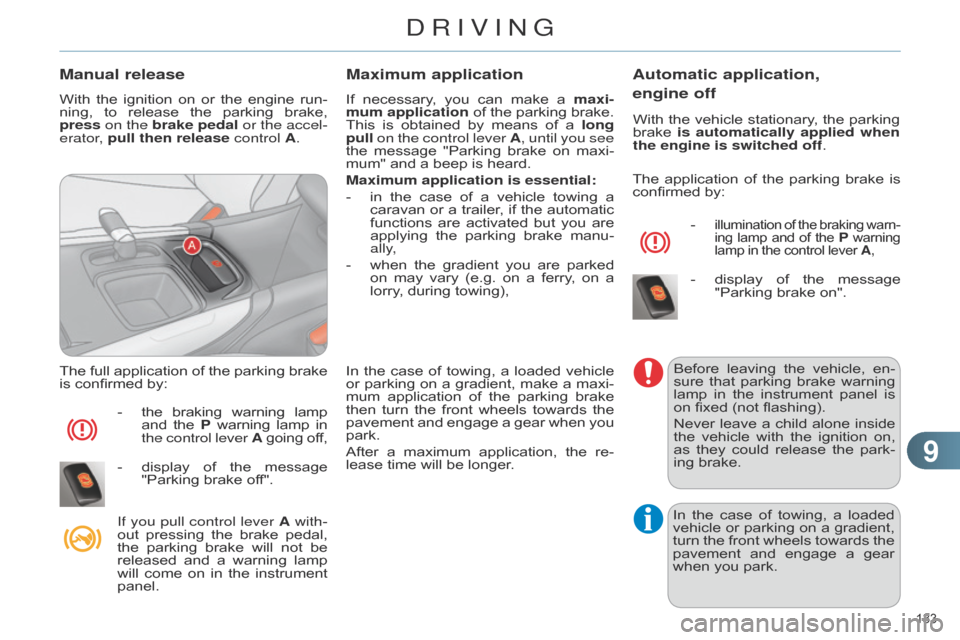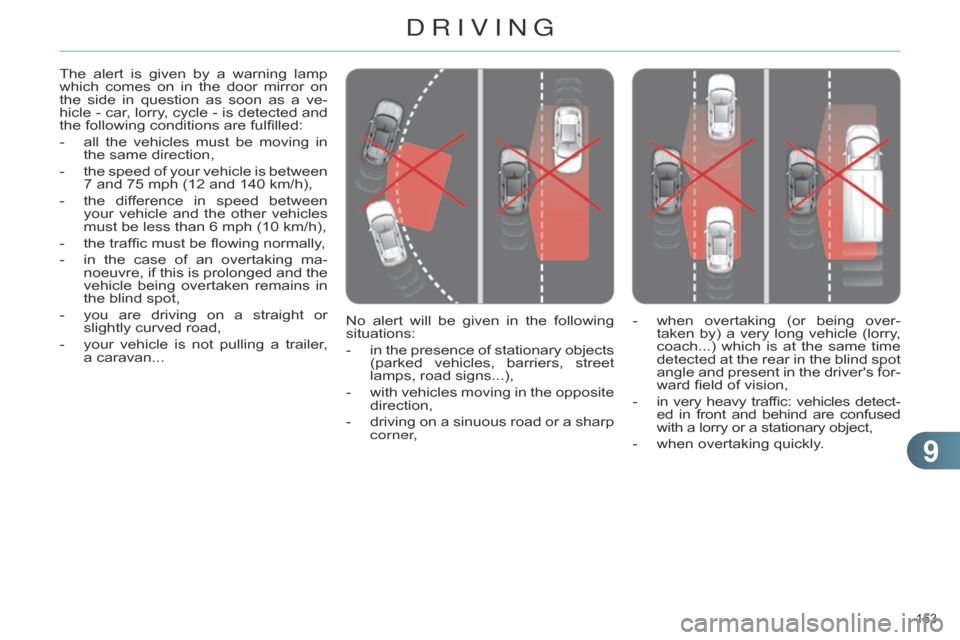trailer Citroen C4 RHD 2015 2.G Owner's Manual
[x] Cancel search | Manufacturer: CITROEN, Model Year: 2015, Model line: C4 RHD, Model: Citroen C4 RHD 2015 2.GPages: 328, PDF Size: 12.72 MB
Page 5 of 328

3
Direction indicators 117
Hazard warning lamps 1 17
Horn
1
17
Braking
assistance systems
1
18
Trajectory
control systems
1
19
Emergency
or assistance call
120
Front
seat belts
121
Airbags
124
8 - SAFETY 1 17 127
Driving recommendations 128
Starting-switching off the engine 129
Electric
parking brake
132
Manual
parking brake
138
Manual
gearbox
138
Electronic
gearbox
139
Automatic
gearbox
142
Hill
start assist
145
Gear
efficiency indicator
146
T
yre under-inflation detection
147
Stop
& Start
149
Blind
spot sensors
152
Speed
limiter
156
Cruise
control
158
Parking
space sensors
160
Parking
sensors
162
9 - DRIVING 128 163
Fuel tank 165
Misfuel prevention (Diesel) 167
Running
out of fuel (Diesel)
168
Bonnet
169
Petrol
engines
170
Diesel
engines
171
Checking
levels
172
Checks
175
AdBlue® additive and SCR
system (BlueHDi Diesel) 177
10 - CHECKS 164 183
Temporary puncture repair kit 184
Changing a wheel 189
Snow
chains
195
Changing
a bulb
196
Changing
a fuse
202
12
V battery
206
Energy
economy mode
209
Changing
a wiper blade
209
Fitting
roof bars
210
V
ery cold climate screen
210
T
owing the vehicle
21
1
Towing
a trailer
213
Audio
pre-equipment
214
Accessories
215
11 - PRACTICAL
INFORMATION 184 216
Petrol engines 217
Petrol weights 219
Diesel
engines
221
Diesel
weights
223
Dimensions
225
Identification
markings
226
12 - TECHNICAL
DATA 217 226
Emergency or assistance 227
eMyW ay 229
Audio
system
285
AUDIO and
TELEMATICS 227 318
ALPHABETICAL
INDEX
319
323
CONTENTS
Page 13 of 328

11
ECO-DRIVING
Limit the causes of excess consumption
Spread loads throughout the vehicle; place the heaviest items
in the bottom of the boot, as close as possible to the
rear
seats.
Limit
the
loads
carried
in
the
vehicle
and
reduce
wind
resis
-
tance
(roof
bars,
roof
rack,
bicycle
carrier
,
trailer
...).
Use
a
roof
box in preference.
Remove
roof bars and roof racks after use.
At
the
end
of
winter
,
remove
snow
tyres
and
refit
your
sum
-
mer
tyres.
Observe the recommendations on maintenance
Check the tyre pressures regularly , when cold, referring to the
label in the door aperture, driver's side.
Carry
out this check in particular:
-
before
a long journey,
-
at
each change of season,
-
after
a long period out of use.
Don't
forget
the
spare
wheel
and
the
tyres
on
any
trailer
or
caravan.
Have
your
vehicle
serviced
regularly
(engine
oil,
oil
filter
,
air
filter
,
passenger
compartment
filter
...)
and
observe
the schedule
of
operations
recommended
in
the
manufacturer's service
schedule.
With
a
BlueHDi
Diesel
engine,
if
the
SCR
system
is
faulty
your
vehicle
becomes
polluting;
go
to
a
CITROËN
dealer
or
a
qualified
workshop
without
delay
to
have
the
emissions
of
nitrous
oxides brought back to the legal level.
When
refuellin
g,
do
not
continue
after
the
third
cut-of
f
of
the
nozzle
to avoid any overflow.
At
the
wheel
of
your
new
vehicle,
it
is
only
after
the
first
1
800
miles
(3
000
kilometres)
that
you
will
see
the
fuel
consumption
settle down to a consistent average.
Page 135 of 328

99
133
Manual release
With the ignition on or the engine run -
ning, to release the parking brake,
press
on the brake pedal or the accel-
erator, pull then release control A.
The
full
application
of
the
parking
brake
is
confirmed by:
-
the
braking
warning
lamp and
the
P warning
lamp
in the control lever
A
going
of
f,
-
display
of
the
message
"Parking
brake off".
If you pull control lever A with-
out
pressing
the
brake
pedal,
the
parking
brake
will
not
be
released
and
a
warning
lamp
will
come
on
in
the
instrument
panel.
Maximum application
If necessary, you can make a maxi -
mum application of the parking brake.
This
is
obtained
by
means
of
a
long
pull
on the control lever A, until you see
the
message
"Parking
brake
on
maxi
-
mum"
and a beep is heard.
Maximum application is essential:
-
in
the
case
of
a
vehicle
towing
a
caravan
or
a
trailer
,
if
the
automatic
functions
are
activated
but
you
are
applying
the
parking
brake
manu
-
ally,
-
when
the
gradient
you
are
parked
on
may
vary
(e.g.
on
a
ferry
,
on
a
lorry
, during towing),
In
the
case
of
towing,
a
loaded
vehicle
or
parking
on
a
gradient,
make
a
maxi
-
mum
application
of
the
parking
brake
then
turn
the
front
wheels
towards
the
pavement
and
engage
a
gear
when
you
park.
After
a
maximum
application,
the
re
-
lease
time will be longer.
Automatic application,
engine off
- illumination of the braking warn -
ing lamp and of the P warning lamp
in the control lever A,
- display of the message "Parking
brake on".
Before
leaving
the
vehicle,
en
-
sure
that
parking
brake
warning
lamp
in
the
instrument
panel
is
on
fixed (not flashing).
Never
leave
a
child
alone
inside
the
vehicle
with
the
ignition
on,
as
they
could
release
the
park
-
ing
brake.
In
the
case
of
towing,
a
loaded
vehicle
or
parking
on
a
gradient,
turn
the
front
wheels
towards
the
pavement
and
engage
a
gear
when
you park.
The
application
of
the
parking
brake
is
confirmed
by:
With
the
vehicle
stationary
,
the
parking
brake
is
automatically applied when
the engine is switched off.
DRIVING
Page 155 of 328

99
153
No alert will be given in the following situations:
-
in
the
presence
of
stationary
objects
(parked
vehicles,
barriers,
street
lamps,
road signs...),
-
with
vehicles
moving
in
the
opposite
direction,
-
driving
on
a
sinuous
road
or
a
sharp
corner
,
The
alert
is
given
by
a
warning
lamp
which
comes
on
in
the
door
mirror
on
the
side
in
question
as
soon
as
a
ve
-
hicle
-
car
,
lorry
,
cycle
-
is
detected
and
the
following
conditions
are
fulfilled:
-
all
the
vehicles
must
be
moving
in
the
same
direction,
-
the
speed
of
your
vehicle
is
between
7
and
75
mph
(12
and
140
km/h),
-
the
dif
ference
in
speed
between
your
vehicle
and
the
other
vehicles
must
be
less
than
6
mph
(10
km/h),
-
the
traffic
must
be
flowing
normally,
-
in
the
case
of
an
overtaking
ma
-
noeuvre,
if
this
is
prolonged
and
the
vehicle
being
overtaken
remains
in
the
blind
spot,
-
you
are
driving
on
a
straight
or
slightly
curved
road,
-
your
vehicle
is
not
pullin
g
a
trailer
,
a caravan... -
when overtaking (or being over -
taken by) a very long vehicle (lorry ,
coach...)
which
is
at
the
same
time
detected
at
the
rear
in
the
blind
spot
angle
and
present
in
the
driver's
for
-
ward
field of vision,
-
in
very
heavy
traffic:
vehicles
detect
-
ed
in
front
and
behind
are
confused with
a lorry or a stationary object,
-
when
overtaking quickly.
DRIVING
Page 165 of 328

99
163
In addition to the rear parking sensors, the
front parking sensors are triggered when
an
obstacle
is
detected
in
front and
the
speed
of
the
vehicle
is
still
below 6
mph (10 km/h).
The
front parking sensors are interrupted
if
the
vehicle
stops
for
more
than
three seconds
in
forward
gear
,
if
no
further
ob
-
stacles
are
detected
or
when
the
speed of
the vehicle exceeds 6 mph (10 km/h).
Front parking sensorsDeactivation/Activation of the front
and rear parking sensors
The
function
is
deactivated
by
pressing
this
button.
The
indicator
lamp
in
the
button
comes on.
Pressing
this
button
again
reactivates
the
function.
The
indicator
lamp
in
the
button
goes off.Operating fault
The function will be deactivated automatically
if a trailer is being
towed
or
a
bicycle
carrier
is
fit
-
ted
(vehicle
fitted
with
a
towbar
or
bicycle
carrier
recommended
by
CITROËN). In
bad
weather
or
in
winter
,
en
-
sure that the sensors are not
covered
with
mud,
ice
or
snow
.
When
reverse
gear
is
engaged,
an
audible
signal
(long
beep)
in
-
dicates
that
the
sensors
may
be
dirty
.
Certain
sound
sources
(motor
-
cycle,
lorry
,
pneumatic
drill,
etc.)
may
trigger
the
audible
signals
of
the parking sensor system.
In
the
event
of
a
malfunction
of
the
system,
when
reverse
gear
is
engaged
this
warn
-
ing
lamp
is
displayed
in
the
instrument
panel
and/or
a
message
appears
in
the
screen,
accompanied
by
an
audible
signal
(short beep).
Contact
a
CITROËN
dealer
or
a
quali
-
fied workshop.
The
sound
emitted
by
the
speaker
(front
or
rear)
indicates
whether
the
obstacle
is
in
front
or
behind.
DRIVING
Page 215 of 328

1111
213
TOWING A TRAILER
We recommend the use of genu -
ine CITROËN towbars and their
harnesses
that
have
been
tested
and
approved
from
the
design
stage
of
your
vehicle,
and
that
the
fitting
of
the
towbar
is
en
-
trusted
to
a
CITROËN
dealer
or
a
qualified workshop.
If
the
towbar
is
not
fitted
by
a
CITROËN
dealer
,
it
must
still
be
fitted
in
accordance
with
the
vehicle
manufacturer's
instruc
-
tions.
Your
vehicle
is
primarily
designed
for
transporting
people
and
luggage,
but
it
may
also be used for towing a trailer.
Driving
with
a
trailer
places
greater
de
-
mands
on
the
towing
vehicle
and
the
driver
must take particular care.
Driving advice
Distribution of loads
F
Distribute
the
load
in
the
trailer
so
that
the
heaviest
items
are
as
close
as
possible
to
the
axle
and
the
nose
weight
approaches
the
maximum
permitted
without exceeding it.
Air
density
decreases
with
altitude,
thus
reducing
engine
performance.
Above
1
000
metres,
the
maximum
towed
load
must
be
reduced
by
10
%
for
every
1 000
metres of altitude.
Side wind
F
T
ake
into
account
the
increased
sensitivity
to side wind.
Cooling
Towing
a
trailer
on
a
slope
increases
the
temperature of the coolant.
As
the
fan
is
electrically
controlled,
its
cooling
capacity
is
not
dependent
on
the
engine speed.
F
T
o
lower
the
engine
speed,
reduce
your
speed. The
maximum
towed
load
on
a
long
in
-
cline depends on the gradient and the ambient
temperature.
In all cases, keep a check on the
coolant
temperature.
F
If
the
warning
lamp
and
the
ST
OP
warning
lamp
come
on,
stop
the
vehicle
and
switch
of
f
the
engine
as
soon
as possible.
Braking
Towing
a
trailer
increases
the
braking
distance.
T
o
avoid
overheating
of
the
brakes
on
a
long
mountain
type
of
descent,
the
use
of
engine braking is recommended.
Tyres
F
Check
the
tyre
pressures
of
the
towing
vehicle
and
of
the
trailer
,
observing
the
recommended
pres
-
sures.
Lighting
F
Check
the
electrical
lighting
and
sig
-
nalling
on the trailer.
Refer
to
the
"T
echnical
data"
section
for
details
of
the
weights
and
towed
loads
which
apply to your vehicle.
The
rear
parking
sensors
will
be
deactivated
automatically
if
a
genuine
CITROËN
towbar
is
used.
PRACTICAL INFORMATION
Page 221 of 328

219
* The kerb weight is equal to the unladen weight + driver (75 kg).
**
The
weight
of
the
braked
trailer
can
be
increased,
within
the
GTW
limit,
if
the
GVW
of
the
towing
vehicle
is
reduced
by
an
equal amount. Warning: towing using a lightly loaded towing vehicle may have an adverse effect on its road holding.
PETROL WEIGHTS AND TOWED LOADS ( IN KG )
The GTW and towed load values indicated are valid up to a maximum altitude of 1 000 metres; the towed load mentioned must
be reduced by 10 % for each additional 1 000 metres of altitude.
When
towing, the maximum authorised speed is reduced (comply with the legislation in force in your country).
High
ambient
temperatures
may
result
in
a
reduction
in
the
performance
of
the
vehicle
to
protect
the
engine;
if
the
ambient
temperature
is above 37 °C, limit the towed load.
Petrol engine
VTi 95 THP 110VTi 120
Gearbox Manual Manual Manual Automatic
Model code:
NC... 8FR0HNZ6
HNZ6/1 -/2 5FS05FS9
5FS9/D
-
Unladen
weight
1 200
1 200
1 205
1 270
-
Kerb
weight*
1 275
1 275
1 280
1 345
-
Gross
vehicle weight (GVW)
1 720
1 770
1 765
1 755
-
Gross
train weight (GTW)
on
a 12 % gradient
2 920
2 970
3 065
3 055
-
Braked
trailer (within the GTW limit)
on
a 12 % gradient
1 200
1 200
1 300
1 300
-
Braked
trailer**
(with
load
transfer
within
the
GTW
limit)
1 450
1 450
1 550
1 550
-
Unbraked
trailer
635635640670
-
Recommended
nose weight
75757575
12
TECHNICAL DATA
Page 222 of 328

220
* The kerb weight is equal to the unladen weight + driver (75 kg).
**
The
weight
of
the
braked
trailer
can
be
increased,
within
the
GTW
limit,
if
the
GVW
of
the
towing
vehicle
is
reduced
by
an
equal amount. Warning: towing using a lightly loaded towing vehicle may have an adverse effect on its road holding.
The
GTW
and
towed
load
values
indicated
are
valid
up
to
a
maximum
altitude
of
1
000
metres;
the
towed
load
mentioned
must
be reduced by 10 % for each additional 1 000 metres of altitude.
When
towing, the maximum authorised speed is reduced (comply with the legislation in force in your country).
High
ambient
temperatures
may
result
in
a
reduction
in
the
performance
of
the
vehicle
to
protect
the
engine;
if
the
ambient
temperature
is above 37 °C, limit the towed load.
Petrol engine
e-THP 130THP 155
Gearbox ManualElectronic
Model code:
NC... HNYM/S
HNYM/1S 5FV8/P
-
Unladen
weight
1 205
1 275
-
Kerb
weight*
1 280
1 350
-
Gross
vehicle weight (GVW)
1 790
1 805
-
Gross
train weight (GTW)
on
a 12% gradient
3 090
3 205
-
Braked
trailer (within the GTW limit)
on
a 12% gradient
1 300
1 400
-
Braked
trailer** (with load transfer within the
GTW
limit)
1 550
1 650
-
Unbraked
trailer
640675
-
Recommended
nose weight
7575
12
TECHNICAL DATA
Page 225 of 328

223
* The kerb weight is equal to the unladen weight + driver (75 kg).
**
The
weight
of
the
braked
trailer
can
be
increased,
within
the
GTW
limit,
if
the
GVW
of
the
towing
vehicle
is
reduced
by
an
equal amount. Warning: towing using a lightly loaded towing vehicle may have an adverse effect on its road holding.
DIESEL WEIGHTS AND TOWED LOADS ( IN KG )
The GTW and towed load values indicated are valid up to a maximum altitude of 1 000 metres; the towed load mentioned must
be reduced by 10 % for each additional 1 000 metres of altitude.
When
towing, the maximum authorised speed is reduced (comply with the legislation in force in your country).
High
ambient
temperatures
may
result
in
a
reduction
in
the
performance
of
the
vehicle
to
protect
the
engine;
if
the
ambient
temperature
is above 37 °C, limit the towed load.
Diesel engine
HDi 90 HDi 90 FAP BlueHDi 100 e-HDi 115
Gearbox Manual ManualManualManual
Model code:
NC... 9H j C
9H j C/1
9HP0 BHY6
BHY6/1 BHY6/2S 9HD8/S
9HD8/1S 9HD8/2S
-
Unladen
weight
1 248 1 205 1 200 1 205 1 280 1 280
-
Kerb
weight*
1 323 1 280 1 275 1 280 1 355 1 355
-
Gross
vehicle weight (GVW) 1 745 1 790 1 830 1 840 1 820 1 820
-
Gross
train weight (GTW)
on
a 12 % gradient
2 545 2 890 3 130 3 140 3 120 2 220
-
Braked
trailer (within GTW limit)
on
12 % gradient
800 1 100 1 300 1 300 1 300 400
-
Braked
trailer**
(with
load
transfer
with
the GTW limit)
1 050 1 350 1 550 1 550 1 550 600
-
Unbraked
trailer
640 640 635 640 670 400
-
Recommended
nose weight
757575757575
12
TECHNICAL DATA
Page 226 of 328

224
* The kerb weight is equal to the unladen weight + driver (75 kg).
**
The
weight
of
the
braked
trailer
can
be
increased,
within
the
GTW
limit,
if
the
GVW
of
the
towing
vehicle
is
reduced
by
an
equal amount. Warning: towing using a lightly loaded towing vehicle may have an adverse effect on its road holding.
The
GTW
and
towed
load
values
indicated
are
valid
up
to
a
maximum
altitude
of
1
000
metres;
the
towed
load
mentioned
must
be reduced by 10 % for each additional 1 000 metres of altitude.
When
towing, the maximum authorised speed is reduced (comply with the legislation in force in your country).
High
ambient
temperatures
may
result
in
a
reduction
in
the
performance
of
the
vehicle
to
protect
the
engine;
if
the
ambient
temperature
is above 37 °C, limit the towed load.
Diesel engine
e-HDi 115BlueHDi 115 BlueHDi 120 HDi 150 FAP
Gearbox ElectronicManual Manual Manual
Model code:
NC... 9HD8/1PS 9HD8/2PSBHXM/S
BHXM/1S -/2S BHZM/S
BHZM/1S -/2S RHE8
RHE8/1
-
Unladen
weight
1 205 1 205 1 280 1 280 1 320
-
Kerb
weight*
1 280 1 280 1 355 1 355 1 395
-
Gross
vehicle weight (GVW)
1 825 1 825 1 860 1 860 1 885
-
Gross
train weight (GTW)
on
12 % gradient
3 125 2 225 3 160 3 160 3 385
-
Braked
trailer (within GTW limit)
on
12 % gradient
1 300
4001 300 1 300 1 500
-
Braked
trailer**
(with
load
transfer
with
the GTW limit)
1 550
6001 550 1 550 1 750
-
Unbraked
trailer
635400675675695
-
Recommended
nose weight
7575757575
12
TECHNICAL DATA